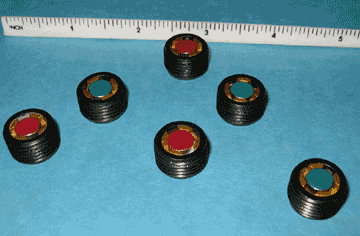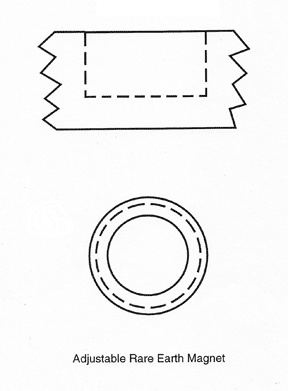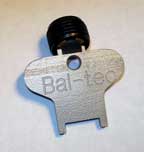Bal-tec™ Home Magnetically Preloaded Kinematic Couplings
Magnetically Preloaded Kinematic Couplings
Positional stability of a Kinematic coupling in its ambient environment requires some mechanical preload. Hertzian elastic deformation of the Kinematic components begins with their first physical contact. This elastic compliance at the interfaces of the Kinematic components is required to average out the peaks and valleys of the surface texture and to distribute variations in the Young's modulus of elasticity of individual crystals, due to the more or less random orientation of their crystallographic axii within the metallic matrix.
Deadweight, i.e. gravity, is probably the best and most often used force to achieve this preload, but there are many cases in which deadweight or deadweight alone will not do the job. One of these cases is where an asymmetrical load is involved and the off axis forces must be balanced by some other method. Another problem that precludes the use of deadweight as a preload is when the Kinematic coupling assembly is not perpendicular to gravity. Still another case is when a higher than normal resonant frequency is required. To achieve this higher resonate frequency, a higher preload is required. If the hardware is in outer space, there is no gravity.
Magnetic Preload
For applications that require a preload other than or in addition to gravity, a permanent magnetic field or magnetic fields is the first choice. Magnetically preloaded Kinematic coupling assemblies have been successfully constructed that are fully vertical or even upside down. All of the general alternatives such as a spring, a lever, a counter weight or using a positive gas pressure or a vacuum, present problems that are complicated and expensive to resolve. All of these methods are hard to adjust, difficult to align and inject mechanical hysteresis that just will not go away. Most of these techniques are bulky and present serious challenges in a clean room environment.
In the recent past, our designs for magnetically preloaded Kinematic couplings were based on the premise that the magnetic fields providing the preload had to be exactly in line with the axis of each couple. More recently, we have found that the magnetic fields are more forgiving than we had imagined. If the pattern of the magnetic force is well balanced the entire magnetic preload can be outboard of the couples and still provide nanometric repeatability.
Naked Magnets
We stock a wide variety of naked rare earth magnets for applications where they are glued directly into the Kinematic platform.


By placing a powerful rare earth magnet in the center of a very high permeability cylindrical metal cup, which is threaded on the outside diameter, a device is produced that has many excellent features. Because the strength of a magnetic field varies as the square of the distance from the mating attractor, the pull between them varies substantially with only small changes in their separation. By shrouding the rare earth magnet in the high permeability metal cup, stray magnetic fields out the back or around the sides are virtually eliminated. The short-circuiting of the magnetic field out the backside brings it around to the front and almost doubles the magnetic pull.
The high permeability metal cups of all the standard designs are black oxide coated to reduce the tendency for corrosion.The larger diameter designs have four notches in the front face that allows them to be rotated with a special non-magnetic spanner wrench (part number SW-1.) to adjust the distance between the component parts and thus the magnetic pull.

The two smaller magnetic devices are not large enough to use isolated shrouds. They have a hexagonal hole in the rear end of the threaded section opposite the magnet, that is used to hold a hex wrench for easy adjustment from behind.
All of the magnetic assemblies are coded as either North seeking or South seeking polarity. The North seeking have a red end and the South seeking have a green end. Neodymium Boron Iron magnets of commercial quality are the standard because of their relatively low cost to gauss ratio. We can provide higher performance versions of this material that will provide even more magnetic pull in the same size package. Samarium cobalt magnets can be used to raise the Curie temperature of the assembly, thus preserving the magnetic pull at higher temperatures, but at a substantial financial premium.
Clean Room Magnets
All of the standard designs are available with electroless nickel-plated magnets and cups for clean room applications. We produce one, off the shelf design for clean room applications that is a ⅝-inch (15.89 mm) in diameter with 18 threads per inch and is ½ inch (12.7 mm) thick. This is part number CR-625-18-MG-"N" for north seeking or "S" for south seeking. The high magnetic permeability, nickel plated, disk to match this device is part number CR-625-18-HPD.
Custom Made Magnets
We will custom produce larger or smaller magnetic devices with greater or lesser magnetic attraction and black oxide or electroless nickel coating, to your specification. We have produced special designs that range from .090-inch (2.3mm) diameter to four-inch (10.16 mm) diameter with a 500-pound (227 kg) pull away force.
The smallest standard device is a ⅜inch (9.5mm) diameter with 24 threads per inch and is ½-inch (12.7 mm) long. The pull away force of this assembly is approximately 6 pounds (2.7 kg). This is part number 375-24-MG-"N" for north seeking or "S" for south seeking. The other small standard device is part number 500-20-MG-"N" for North seeking or "S" for south seeking. It is ½-inch (12.7 mm) diameter with 20 threads per inch. It is 5/8-inch (15.88mm) long. The high magnetic permeability disk to match this device is part number 375-HPD.
The next larger standard device is a ⅝-inch diameter with 18 threads per inch and is ⅜ of an inch (9.5 mm) long. The pull away force of this assembly is approximately 7 pounds (3.2 kg). This part number is 625-18-MG-"N" for north seeking or "S" for south seeking. The high magnetic permeability disk to match this device is part number 625-11-HDD. We also make the standard ⅝-inch (15.89mm) diameter with 11 threads per inch, which is otherwise, the same as the above. This part number is 625-11-MG-"N" or "S". The high magnetic permeability disk to match this device is part number 1000-11-HDD. The largest standard device is 1.00-inch (19.4 mm) diameter with 14 threads per inch and is ½" (12.7 mm) inch long. This part is number 1000-14-MG-"N" or "S".
Metric Magnets
We will custom manufacturer versions of any of these devices with metric dimensions and metric threads at prices comparable to the American designs.
Alternative Designs
When using a magnetic device to preload a Kinematic coupling, there are two basic approaches. When the maximum pull is desired, two of these magnetic devices, of opposite magnetic polarity, are used across from each other. When less pull is desired a magnetic device is used on one face and a high permeability metal disc with the same exact dimensional properties as the magnet is used on the other. When ordering, designate the desired thread diameter and pitch with either black oxide or nickel plating.
These adjustable magnetic devices are a great asset when one of a kind or prototype Kinematic systems are being developed and the exact magnetic pull required cannot be easily determined. Another interesting approach to magnetic preloading kinematic platforms is to use a permanent magnet on one platform and an electro magnet on the other. By using direct current to excite the electro magnet on one platform, a strong pull will occur with one polarity and an actual ejection will occur when then the polarity is reversed.
Magnetic Preloading Couplings Price List
